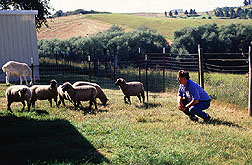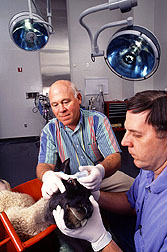New Live—Animal Test for Scrapie
The first practical test for diagnosing the sheep disease scrapie in live animals may help the livestock industry gain the upper hand on and eventually eradicate one of its worst problems. Scientists with the Agricultural Research Service teamed with Washington State University veterinarians to invent the test.
Scrapie was inadvertently introduced from Europe in 1947. The U.S. Department of Agriculture has been trying to eradicate it for decades, but the disease has been intractable. Not only has it been impossible to detect scrapie in live animals, they can harbor it for up to 8 years before showing disease signs.
And scientists haven't fully understood how it is transmitted. Now they believe infectious agents called prions are involved in causing scrapie, but they are still investigating other theories also.
To glimpse what a quick, easy, inexpensive scrapie test might mean to the sheep industry, you first have to know what sheep producers endure without such a test.
Tom and Gail Sloan, sheep breeders in Lawrence, Kansas, specialize in producing breeding stock from purebred Suffolk and Columbia flocks. In 1987, they purchased a yearling ram from a large Suffolk breeder to upgrade their family's flock of 25 Suffolk ewes.
At first the ram appeared healthy, but over the next several months he began losing wool and seemed to have a skin problem. The ram was ultimately found to have scrapie, a brain disease that causes sheep to behave erratically, lose weight, and eventually die.
Per the federal regulations at the time, the Sloans killed the ram and all of his progeny, carried out a rigorous cleaning program, and instituted long-term monitoring to eliminate all traces of the disease.
The Sloans bought more ewes but again learned too late they had bought more scrapie. After repeating the steps for ridding the flock of known and potential scrapie carriers, they spent 6 months searching for a closed flock with a good health program. Once again, they inadvertently purchased scrapie.
This time, the Sloans destroyed all their Suffolk sheep. They have purchased a limited number of Suffolks, but they keep them at another farm.
"I'm afraid to let Suffolk sheep back on our home farm because of our experience with scrapie," Gail says. "I'm not sure our family could survive going through this again."
Effects Can Be Subtle
The Sloans' story gives only a hint of the impact scrapie has on the U.S. livestock industry.
The incidence of scrapie seems low only a few dozen cases are reported annually. Black-faced sheep, including Suffolks, have had the majority of the cases detected nationwide.
"Predation, foot rot disease, and parasitism have a much higher monetary impact on individual flocks," says Paul Rodgers. At the American Sheep Industry Association (ASI) in Christiansburg, Virginia, Rodgers is Director of Animal Health, Product Safety, and Technical Services.
The disease's effect on the global marketplace, though, is far greater.
"Countries that don't have scrapie have shied away from purchasing our sheep," says Ron Young, an Ohio sheep producer who serves on the board of directors for the Suffolk Association. "American sheep are big, meaty, and fast-growing, so other countries are hungry for our genetics. But from a health protocol standpoint, we're not able to export animals to those countries."
Other livestock exports are also affected.
Scrapie is known as a transmissible spongiform encephalopathy (TSE). Related diseases affect cattle, elk, deer, mink, cats, and humans. Bovine spongiform encephalopathy (BSE), the TSE of cattle also known as mad cow disease has been a problem in some other countries.
|
|
BSE has never been detected in American cattle, and a strict surveillance and prevention program is in place to prohibit its entry.
"Scrapie is a big stigma worldwide, " says Linda Detwiler, senior staff veterinarian with the USDA's Animal and Plant Health Inspection Service (APHIS). "The fact that we have scrapie affects our BSE status that is, other countries have not declared us totally free of BSE for trading purposes, even though we don't have that disease because any TSE is considered a risk factor."
A Simple, Safe Test
The problem is that until now, the only way to confirm any TSE has been to examine the brain of a dead animal. Now that could change.
A research team headed by ARS microbiologist Katherine I. O'Rourke discovered that prions collect in pockets of lymphoid tissue in a sheep's nictitating membrane, or third eyelid. A veterinarian can take a sample of the tissue with only a local anesthetic.
O'Rourke works in the ARS Animal Disease Research Unit at Pullman, Washington. Others on the team include Donald P. Knowles, who leads the Pullman lab, Timothy V. Baszler and Steven M. Parish with Washington State University in Pullman, and Janice M. Miller at the ARS National Animal Disease Center in Ames, Iowa.
This test offers several advantages over other options currently being pursued. While abnormal prions are known to collect in tonsils and other lymphoid tissues, tests using those tissues require a general anesthesia. The ARS test is safer and easier and will be much less expensive than more invasive procedures.
Another advantage is that the new test relies on a laboratory-built molecule known as a monoclonal antibody. A monoclonal antibody is a specific series of amino acids that recognize and bind to a specific protein, in this case prions. The antibody can be standardized and replicated indefinitely in the laboratory.
Other existing tests use rabbit antibodies. Because one rabbit can provide only a limited amount of serum, it isn't possible for all copies of the test worldwide to be identical. Normal biological variation in antibodies from multiple rabbits adds variability to a test.
In the new test, a red color indicates that scrapie prions are present in the sample. The color comes from an enzyme on a reporter molecule that detects the monoclonal antibody bound to prions. ARS has applied for a patent on the monoclonal antibody and testing for prions in ruminant eyelids (Patent Application No. 08/950,271).
Before the test can be made available, it must be validated and receive regulatory approval.
|
|
"We need to know whether and how often the test produces false positives or false negatives. So far, the results look promising," says O'Rourke.
APHIS is helping to provide the ARS lab with scrapie-positive samples. O'Rourke also plans to get samples from New Zealand, a scrapie-free country, as scrapie-negative samples. The validation could be completed within 2 years.
Even though the test is not yet available, sheep producers are excited.
"A preclinical, live-animal diagnostic test will allow us to eventually eradicate this disease in the United States and allow us new export opportunities," says ASI's Rodgers.
The test will have two other important uses: confirming scrapie in dead animals and verifying recently identified genetics that may indicate susceptibility to scrapie.
"Sheep with certain genetics seem more likely to show clinical signs of the disease after exposure, but we don't know if animals without the sequences still carry and pass on the prions," says O'Rourke. "Our new test will help us determine the relationship between genetics and prion accumulation, which is crucial to eradicating the disease," she says.
"Once we can definitely say that an animal does not have scrapie, we'll be able to open many doors for purebred livestock breeders," says breeder Young. "In the past, we've just been throwing darts in the dark."
Another piece of the scientific puzzle: At what age do prions become detectable in lambs? The new test has identified prions in 1-year-old sheep. The lab's next step is to follow, from birth, lambs born to ewes known to have scrapie.--By Kathryn Barry Stelljes, Agricultural Research Service Information Staff.
Katherine I. O'Rourke and Donald P. Knowles are in the USDA-ARS Animal Disease Research Unit, 337 Bustad Hall, Washington State University, Pullman, WA 99164; phone (509) 335-6020, fax (509) 335-8328.
"New Live-Animal Test for Scrapie" was published in the November 1998 issue of Agricultural Research magazine. Click here to see this issue's table of contents.










